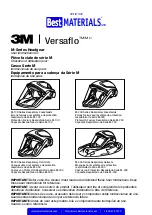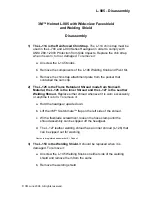
Transporting Machines
Do not leave grass or debris in the bagger while transporting
the machine on a trailer or truck.
DANGER
Transporting the machine with grass or debris in
the bagger can damage the machine.
Do not leave grass or debris in the bagger while
transporting the machine on a trailer or truck.
Operating Tips
Machine Size
Remember that the machine is longer and wider with this
attachment installed. By turning too sharply in confined
places you may damage the attachment or other property.
Trimming
Always trim with the left side of the mower. Do not trim
with the right side of the mower because you could damage
the bagging tubes. Ensure the bagger handle does not catch
on obstacles while trimming.
Cutting Height
For optimum bagging performance, set the deck height-of-cut
to remove no more that 2 to 3 inches (51 to 76 mm) or 1/3 of
the grass height, which ever is less. Cutting off more than this
will reduce the capacity of the vacuum system.
Cutting Frequency
Cut the grass often, especially when it grows rapidly. You will
have to cut your grass twice if it gets excessively long (refer to
Bagging Long Grass).
Cutting Technique
For best lawn appearance, be sure to slightly overlap the
mower into the previously cut area. This helps reduce the
load on the engine and reduces the chance of plugging the
blower assembly and tubes.
Bagging Speed
The bagging system may plug if you drive too fast and the
engine speed gets too slow. On hills it may be necessary to
slow the machines ground speed. Mow down hill whenever
possible.
CAUTION
As the bagger fills, extra weight is added to the back
of the machine. If you stop and start suddenly on
hills, you may lose steering control or the machine
may tip.
•
Do not start or stop suddenly when going uphill
or downhill. Avoid uphill starts.
•
If you do stop the machine when going uphill,
disengage the PTO. Then back down the hill
using a slow speed.
•
Do not change speeds or stop on slopes.
Bagging Long Grass
If the grass is ever allowed to grow longer than normal, or if
it contains a high degree of moisture, raise the cutting height
higher than usual and cut and bag the grass at this setting.
Then cut and bag the grass again using the lower, normal
setting.
Excessively long grass is heavy and may not be propelled
completely into the bagger. If this happens, the tube and
blower may plug. To avoid plugging the bagging system, mow
the grass at a high height-of-cut, then lower the mower to
your normal cutting height and repeat the bagging process.
Bagging Wet Grass
If possible, always try to cut grass when it is dry. Wet grass
can cause plugging.
Reducing Plugging
To avoid plugging the bagging system, reduce ground speed
and mow the grass at a high height-of-cut, then lower the
mower to your normal cutting height and repeat the bagging
process.
Signs of Plugging
As you are bagging, a small amount of grass clippings
normally blow out the front of the mower. An excessive
amount of clipping blow-out indicates that the bagger is full
or the tube is plugged.
Bagging Blades
In most mowing conditions, the standard high lift blades will
provide the best bagging performance.
The Toro Atomic blade is recommended for bagging leaves
in dry conditions. In dry dusty conditions, the medium lift
or low lift blades will reduce dust and dirt blowout while
providing effective bagging air flow.
Contact an Authorized Service Dealer for the proper blades
for different mowing conditions.
20
Summary of Contents for 30460
Page 29: ...Notes 29...
Page 30: ...Notes 30...













































